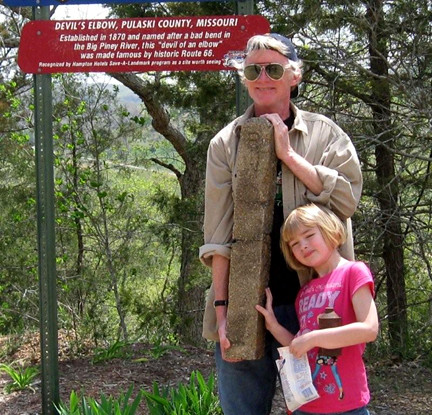
Longtime roadie Kip Welborn was near the Route 66 town of Devil’s Elbow, Mo., when he found something interesting. I’ll let him tell the story:
When we got to Devils Elbow, a bizarre find … we stopped at the scenic overlook. … I climbed down the hill in search of old beer cans … did not find many, but, about a hundred yards down the hill (guessing) did find a concrete right of way marker just laying there on the side of the hill. I have never seen a concrete marker in Missouri (they are fairly common in Illinois; the ones in Missouri I have seen are metal triangular signs).
On one side, the letters “RW” are embossed (it looks like the markers you see all over the place in Illinois — there may be some in Missouri, but I have never seen one) … I will likely contact the 66 Museum at Route 66 State Park at some point in the not too distant future and see if they want to display it — let’s face it, you can only stare at something for so long, and I would rather have others enjoy and appreciate it. It is apparently from the mid/late 1920’s,according to the information I have received thus far.
The “RW” on the marker probably means “right of way.” I saw a very similar concrete highway marker today on Oklahoma Highway 18 north of Shawnee.
I’m fairly sure that Welborn’s source is accurate, that the highway marker dates to the 1920s. These markers were common in the days before highways were officially numbered by the U.S. government.
UPDATE: Jane Lee, a historian with the Missouri Department of Transporation, e-mailed me with helpful information about the marker:
The concrete post pictured is assuredly an old Missouri State Highway Commission right of way marker. The marker would have been buried approximately 2 feet in the ground, with only the top 6 inches or so exposed above the ground surface. The letters RW–standing for Right of Way–would have been stamped on the top of the post while the concrete was still “plastic.” The letters would be visible on the above ground portion of the marker. Markers such as this were situated on both lines of the RW (on either side of the highway), and were placed on the tangent of an angle in the RW line, when the RW didn’t curve. I’ll attach a drawing of a concrete RW marker that visually illustrates what I’m trying to describe…a picture really is worth a thousand words.
The attached drawing was included in a set of highway plans from Route 66 near Arlington, Missouri. The plans are dated to 1927, but I believe that the markers were used even earlier. I imagine that the marker might have been set along the RW around the time that Route 66 was designated (1926), or maybe even before the official designation, when Route 66 in Missouri was still called Route 14. I don’t think that there is any way to know the exact date that the marker was placed, but the 1920s estimate is accurate. This segment of Route 66 near Devil’s Elbow was bypassed by a “new” alignment of Route 66 in 1942 with the construction of the famous Hooker Cut. I would guess that the marker was dug out of the ground and discarded down the slope sometime after the realignment. It had probably been lying there since the 1940s or 1950s, until Mr. Welborn discovered it!
Here’s a thumbnail of the highway marker plans. Click on it to see it in full size.
On an aside, Lee is in charge of organizing a museum-quality exhibit at the new Route 66-themed Welcome Center near Conway, which is having a ceremonial grand opening on Monday at 11 a.m.
Good work Kip!
Congratulations, Kip, on your find, and thanks for your willingness to share it with others through the museum. As you noted, there are quite a number of these markers along the older alignments of 66 in IL. The ones I have seen are still in the ground, though several have been broken (presumably) when hit by a vehicle; a metal pole in the center holds the broken pieces together. I have discovered some well-hidden by weeds in the corners of fields, etc., and my wife has found some I’ve missed! If they ever break off completely and fall to the ground, I hope someone like Kip finds them and gets them to the museum in Pontiac.
That’s great Kip! Congratulations!
I think, though, that you should have dressed up like Indiana Jones in the picture.
Wow! I used to think Michael Wallis was simply waxing poetic about the Mother Road being alive & breathing, but now that Kip has helped it pass a stone, I believe. Way to go Kip!
We are located in Osceola, Missouri and today we have found two of these on a piece of family property, which my uncle owned previously, we are doing a Reno on the house there to raise my children in! We find the coolest stuff here all the time! Too leave them buried in the ground or dig them up???